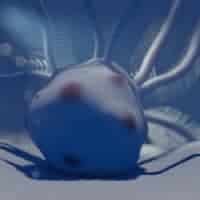Scientists from The University of Western Australian and University of Cambridge have made a chance discovery in UK museum collections, finding hollow ball-like structures in 80-million-year-old fossils from species believed to be related to starfish and sea urchins.
The scientists found the unusual structures known as ‘bucky’ balls made up of a series of hexagons and pentagons in two species – the Uintacrinus socialis and Marsupites testudinarius. They believe the structures might have acted as a buoyancy chamber to allow the crinoid organisms to float in seawater but also protect them.
UWA Adjunct Research Fellow Aaron Hunter from UWA’s School of Earth Sciences said crinoids were in a very dangerous place millions of years ago when the oceans were shallower and they shared them with predators such as crabs and fish.
“Survival was critical and the ball-like structures, able to withstand very heavy loads, formed around them to protect them from the harms of the ocean and aid buoyancy,” Dr Hunter said.
“These animals could then spread around the world and have been found in chalk rocks from Texas, US to Kalbarri in Western Australia. They could form a snow shoe to sit on the bottom of the shallow oceans or float and relocate to safer places.”
Dr Hunter said in comparing the two species, Marsupites testudinarius had fewer but relatively large plates, creating a stable structure.
“Uintacrinus socialis on the other hand has far more complex plates that form a dome,” he said.
“The structures are also found in the carbon molecule Buckminsterfullerene but this is the first time we have found such a structure in fossils and it still remains a mystery why these successful structures did not evolve again.”
“Later, architect Buckminster Fuller would rediscover and popularise these structures and apply them to creating iconic buildings such as the Eden project in Cornwall in UK. However most would recognise the structure in the humble soccer ball we know and love.”
Media references
Jess Reid (UWA Media and PR Adviser)

